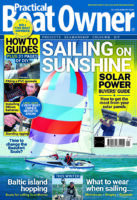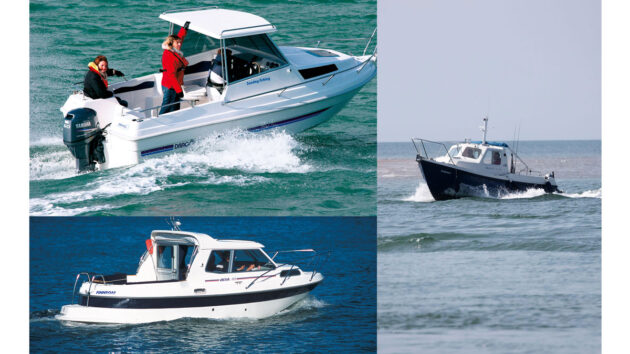If you want a small, multi-purpose motorboat with simple accommodation, you have a choice of an inboard or outboard engine and a planing or displacement hull. David Harding gets to grips with three very different examples of pilothouse boats...
Three pilothouse boats: Bella 703, Orkney Day Angler 20 and Drago Sunday Fishing
When it comes to small motorboats, the Finns know a thing or two.
They use them as transport between the islands, for picnics or simply for messing about and having fun.
Many Finns practically live on the water during the summer, so they need boats that work as hard as they play.
Those who want to whiz around have plenty of choice – but some prefer the steadiness and economy that go with lower speeds, which is why the Bella 703 is still selling well after more than 25 years and 2,000 boats.
Bella 703

The Bella 703 powerboat has a spacious double bunk inside
One reason for the Bella’s success is that, although no flyer, she’s faster than she looks.
A quick glance at her double-ended hull might make you think that she would reach seven knots if pushed hard enough.
A more thorough appraisal, however, reveals a skirt beneath the stern similar in concept to that used by the larger, British-designed Kents (see PBO 468).
By minimising stern-squat, the skirt lets the shaft-driving, 40hp Yanmar 3JH4-E diesel push her along at up to 10 knots.
A 67lt (15gal) tank and a consumption of about 4-5lt (1gal) an hour give up to 15 hours’ running between fuel stops and a range approaching 150 miles.
Rounded reasoning
As on the Kents, the round stern seems to offer practical as well as aesthetic advantages.
I noticed a welcome absence of the usual vortex that drags spray and fumes into the cockpit and can make it a damp and smelly place to sit.
The skirt seems to limit rolling, too, though a boat of this size and weight is inevitably more responsive to crew movement than a heavier or chined hull.
Upwind, the flared bow throws the spray well away and keeps her dry, and even in the short Finnish chop during my tests she rarely slammed.
All you need to get used to on the handling front is the generous turning circle induced by the long keel.
Pilothouse accommodation
Moving from the cockpit to the interior, you find one of the recent additions to the Bella: a sea toilet to port beneath the after-most, hinge-up section of the saloon seat.
The galley and helm station are to starboard, opposite the dinette, and the seat ahead of the table has a backrest that hinges forward when you’re sitting at the table, or aft to make it into a co-pilot’s seat beneath the large overhead hatch.
A massive double bunk occupies the bow.
Conclusion
A full interior moulding gives the Bella a slightly plasticky and mass-produced feel, but she’s an engaging, versatile and highly practical little boat suitable for both inland and coastal waters.
She deserves to do as well in the UK as she has in her native Finland.
SPECIFICATION
LOA: 7.05m (23ft 2in)
Beam: 2.47m (8ft 1in)
Draught: 0.6m (2ft)
Displacement: 1,200kg (2,646lb)
Fuel: 67lt (15gal)
Engines: Yanmar 40hp diesel
RCD category: C
BUILDER: BellaBoats, Finland www.bellaboats.fi
UK DISTRIBUTOR: TL Harvey Ltd, www.tlharvey.com
Orkney Day Angler 20

The Orkney 20 pilothouse boat is light enough to trail behind a family car. Credit: Richard Tadman/Alamy
Designed by Arthur Mursell – the man behind the Nelsons and Seawardsamong others – Orkney’s 20-footer was conceived as a true all-rounder.
She had to be capable of facing open water and providing reasonable shelter from the elements while still being light enough to trail behind a family car.
She also had to reach over 20 knots in a laden state when powered by the maximum size of outboard or sterndrive, and to have a cockpit big enough for a party of fishermen.
Achieving all that would be a challenge for any designer and builder, but Mursell and Orkney have worked together for many years and, after the Orkadian 20 and Orkney 19, the Day Angler is their third boat of this size.
Spacious design
The cockpit is where many owners will spend most of their time.
Nearly 2.1m (7ft) square, it feels secure with gunwales 0.76m (2ft 6in) above the self-draining sole.
Lifting the central hatch beneath your feet reveals a moulded well that accommodates up to three 25lt (5.5gal) plastic fuel tanks; a 135lt (30gal) integral stainless tank is on the options list for £1,269 and can easily be fitted later.
It would be worth having if you want to go any distance.
The boat will cruise at 18 knots with an 80hp, four-stroke outboard drinking about 18lt (4gal) an hour, so each plastic tank would keep you running for just under one-and-a-half hours.
Two batteries live in a separate compartment abaft the fuel, while either side of the centreline are lockers for warps and fenders.
Making space
Given the size of the cockpit and the hull length of less than 6m (20ft), the Orkney has a useful pilothouse.
To starboard is the helm station, and to port a removable seat for two crew over the basic galley.
Further forward is a V berth that converts to a double and incorporates space for a chemical toilet.
There’s plenty of headroom, a reasonable amount of stowage and, at the wheel, space for a chart plotter and VHF as well as the switch panel and engine instrumentation.
Sliding windows on either side provide ventilation.
On the outside, pilot boat-style stainless rails run along the top of the wheelhouse and form a frame over the forward part of the coachroof.
Combined with the optional guardrails, angled edges to the side decks and a substantial pulpit, they make moving forward a much more secure operation than on most boats several feet longer.
Performance plus
Our test boat from BHG Marine in Lymington was powered by a four-stroke 80hp Yamaha and hopped up onto the plane at 10 knots with four of us on board.
Full throttle saw us make 26 knots with the Force 5 and small chop behind us, and 23 knots the other way accompanied by a modest amount of banging.
Turning at speed was accompanied by gentle banking.
Conclusion
Given her relatively light weight, the Orkney 20 has a reassuring feel.
She’s a clever, no-frills design that has met the needs of commercial users and will also satisfy a wide range of private owners.
SPECIFICATION
LOA: 5.95m (19ft 6in)
Beam: 2.4m (7ft 10in)
Weight (exc.engine): 816kg (1,800lb)
Engine: Outboard (max80hp) or sterndrive (max120hp)
RCD category: C
BUILDER: Orkney Boats Ltd, www.orkneyboats.com
Test boat supplied by: BHG Marine of Lymington, www.bhg-marine.co.uk
Drago Sunday Fishing

The Drago Sunday Fishing powerboat is a zippy little fishing boat-cum-runabout with a permanent shelter
If you want something smaller, lighter and cheaper than the Orkney, the 5.4m (17ft 9in) Drago might be one to consider.
Competition for boats of similar size from Quicksilver and Selva, this Greek design is built in a factory that not only laminates and fits out the hulls but also produces the stainless steel work, windscreens, tanks and upholstery.
As you would expect, the shallow, keel-less hull allows good speeds with relatively small outboards.
BHG Marine’s demonstration model had a four-stroke 60hp Yamaha on the stern and, four-up, zipped along at 26 knots.
Mid-range performance, however, was less convincing with this weight aboard as the boat climbed over a substantial hump and would fall back again if the revs were allowed to drop below 4,000.
Fast or slow suited her best.
Given the full 90hp for which she’s rated, the Drago would fly in flat water but opportunities to use full throttle would inevitably be limited by the sea state.
Most buyers are opting for 50-60hp.
Feeling the breeze
With such a high-sided wheel-shelter on a hull like this, you can’t ignore the wind: it was blowing hard enough during our trials for the boat to give an impressive demonstration of her side-slipping abilities.
Getting on and off a pontoon, whether a leeward or a windward berth, took some doing.
Even heading back up the river with the wind on either bow called for substantial compensation to allow for our crab-like course.
You also have to leave room for a good deal of skidding in the turns.
Increasing the grip would call for a keel or for greater deadrise, either of which limit the speed from any given size of engine.
So if you want lots of knots and protection at the helm, you have to get used to going sideways on occasions.
Abaft the seats for the helmsman and co-pilot, the self-draining cockpit has space beneath the sole for an integral fuel tank.
Alternatively, you can save cash by having a standard 25lt plastic tank in the locker between the two stern seats.
Cabin comforts
The Drago differs from some of the competition in having an open-backed wheel shelter separate from the cabin.
Ducking forward through the acrylic door, you find carpet-lined hull-sides and two berths that, with the infill, form a double 2.05m (6ft 9in) long and 1.78m (5ft10in) wide at its after end.
Sitting headroom is 0.91m(3ft) above the bunk and the space beneath the cockpit sole, if not occupied by a fuel tank, can be reached from the cabin for stowage.
Conclusion
Any boat with a shallow hull and lots of windage will present challenges when it comes to manoeuvring and recovery on to a trailer in a breeze – but they come as part of the package if you want a zippy little fishing boat-cum-runabout with a permanent shelter.
In this instance, the package comes at a highly competitive price.
SPECIFICATION
LOA: 5.4m (17ft 9in)
Beam: 2.08m (6ft 10in)
Weight (exc. engine): 500kg (1,102lb)
Engine: Outboard (max. 90hp)
RCD category: C
Builder: Drago, Greece
Test boat supplied by: BHG Marine of Lymington, www.bhg-marine.co.uk
Smoothing the cruising – a buyers guide to ‘shock-absorbing’ boat gear and more!
The ability to soften that slamming motion of a fast boat at sea has been greatly helped with more advanced…
Orkney Longliner & Sussex beach boat
Clive Marsh sails from Rye Bay upriver to Bodiam Castle in East Sussex by Orkney Longliner and Sussex beach boat
Around the world in a 5.8m boat! Meet the sailor preparing to race a Class Globe 5.80
British sailor Adam Waugh is currently building his 5.8m boat at his home in Northumberland before taking part in the…
Want to read more boat test articles?

A subscription to Practical Boat Owner magazine costs around 40% less than the cover price.
Print and digital editions are available through Magazines Direct – where you can also find the latest deals.
PBO is packed with information to help you get the most from boat ownership – whether sail or power.
-
-
-
- Take your DIY skills to the next level with trusted advice on boat maintenance and repairs
- Impartial, in-depth gear reviews
- Practical cruising tips for making the most of your time afloat
-
-
Follow us on Facebook, Instagram, TikTok and Twitter







